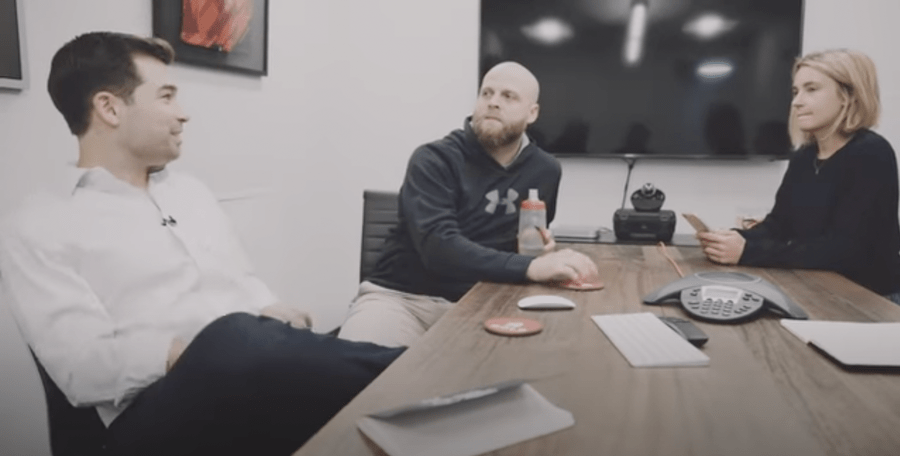B2B Sales Storytelling: A Guide to Sales Growth Using Stories
It's estimated that there are more than 6,000 languages spoken in the world today.
On top of that, there are hundreds of unique cultures and societies that most of us can't even imagine exist.
Yet, there is one thing that unites people from every corner of the world, and has for thousands of years. That thing is storytelling.
Stories are so powerful that they literally propagate through time and link people from opposite ends of the world together. Storytelling is a basic human connection that has, in many ways, shaped the world in which we live.
The power of telling a compelling story is equally great in B2B sales.
In fact, if a B2B company doesn't use storytelling in their sales pitches, they might not make any sales at all.
In this guide to B2B sales storytelling, we are breaking down everything you need to know about telling a story to ignite sales growth, including:
- What sales storytelling is and isn't
- The top sales storytelling tips to turn sales pitches into sales stories
- A simple sales pitch storytelling example
Remember, a sales strategy is nothing without a story, and you can't increase sales (or make any at all) unless you tell a story! Does your sales team know how to sell with a story?
What Is a B2B Story?
There are two key types of stories and storytelling in B2B business, including:
- Brand stories and storytelling
- Sales stories and storytelling
Your company should create both brand and sales stories in your sales and marketing strategies!
Brand storytelling is about creating a compelling narrative behind a brand in order to give it an identity. That identity is one that consumers can connect with on an emotional level, which compels them to buy.
Every company needs to have a compelling brand story to secure their place in the market.
For example, there are dozens of car companies in the world, but people pick the one that they believe tells the most compelling story, and that fits their emotional desires!
B2B marketers primarily tell their brand story through content marketing, such as social media and website content. When a B2B buyer looks over a brand’s content, they should automatically be able to pick up on their unique brand story!
Sales storytelling is the other type of B2B storytelling, and it is the focus of this article.
Sales stories and storytelling is about turning your sales pitches into stories. More specifically, it's about using the prospect’s emotional desires as a basis for a storyline!
The truth is... it's human nature to want to be taken through a story. If you try to swoon your prospects over with things like facts, you’re not going to go anywhere.
On the other hand, if you can turn your prospect’s buyer journey into a thrilling story, then you have a firm grip on a closed sale, because you’ve tapped into their innate human desires.
How effectively you can turn your prospect's customer experience into a good story tells you the odds that you are able to close the sale.

What Is Storytelling In Sales?
Sales storytelling is exactly the same as storytelling in any other realm of life.
It’s all about creating a scene and different characters or personas for the purpose of portraying some kind of message or inspiring an action.
Think about it: The most infamous stories of all time, from The Great Gatsby to The Little Mermaid, all attempt to convey some type of message and get people taking action.
Similarly in B2B marketing and sales, salespeople use stories to inspire their clients to make a purchasing decision.
The trick with sales storytelling is to create and frame a sales pitch as a story using the prospect's unique emotional desires as the basis for the storyline!
And, the truth is... you are already very familiar with storytelling in sales because you've certainly played into it in the past!
Consider this: Think about a time when you were feeling fancy, so you went to a classy restaurant for dinner. When you arrived, the restaurant was playing classical music, the host pulled out your chair for you, and the wait staff called you 'ma'am' or 'sir'. You were loving it so much that you bought several dishes AND left a generous tip. In fact, giving them more money made you feel even more fancy!
While you didn’t know it, the restaurant staff understood your emotional desire was less to eat food and more to feel fancy, so they played into it by treating you like royalty.
Moreover, what they really did was turn your desire to feel fancy into a storyline: They played on those emotions by turning you into royalty, knowing that it would make you willingly spend more money in return.
While you may not work in the restaurant business, it is your job to similarly uncover your prospect's emotions, then turn their buyer journey into a storyline that motivates them to buy!
What Storytelling In Sales Isn’t
Facts tell. Stories sell.
Sales storytelling is not about telling your prospect facts about your product or service. It's not about mentioning this data point, and this figure, and blah blah blah.
Facts don't create a storyline, emotions do!
When was the last time someone telling you facts ever made you motivated to buy something? Probably never, because it goes against human nature.
For example, which statement motivates you more to buy:
- “This car has 400 horsepower”
- “This car is the most powerful sport SUV in its class”
The first statement is a mere fact that a prospect could have read on your website or in a brochure. It’s a waste of time to mention in the sales pitch because it evokes little to no emotion. Moreover, you can’t make a good story out of it!
On the other hand, the second statement frames the car in an emotional manner…. It’s not just a powerful car, it’s the most powerful in its class. Driving the most powerful vehicle in its class will surely fulfill someone’s desire to feel cool and look even cooler! Moreover, you can make a story out of this statement because it feeds into an emotional desire.
In no way are we saying that prospects shouldn't get the facts on a product or service. Instead, what we are saying is that facts don't create a good storyline for sales pitches.
Therefore, structure your sales pitches around the emotional aspects of your product or service, and then state the facts in writing so you don’t have to say them all out loud.
For example, if you are using PowerPoint for your pitch, list the facts in your slides, but make your script an emotionally-charged version of those facts to tell the story!
Facts tell. Stories sell.
What Are the Benefits of Storytelling?
What are the benefits of storytelling in sales?
Plain and simple: You cannot sell anything unless you use storytelling to sell it.
The power of storytelling in sales is that it motivates potential customers to make a purchasing decision in your favor.
Not only does storytelling benefit the salesperson, but it satisfies the prospect's deepest emotional desires!
And, the truth is, when people make a purchasing decision, 90% of the reason why they make it is to fulfill those emotional desires.
Don't agree?
Consider this: The purpose of a car is simply to get you from point A to point B. Yet, today, there are more than 60 major automotive brands in the world. If people bought cars for the simple purpose of getting from point A to point B, the first automotive group in the world (Peugeot) would be the only one around today because it satisfies the need for people to get from point A to point B.
However, the reason there are more than 60 automotive groups in the world today is because each of them tells a different story to fulfill a different set of emotional desires.
Think about this: Volkswagen Group owns and manufactures several car brands, including VW, Audi, and Porsche... Why would Volkswagen Group sell several different branded cars when one single brand would satisfy the need to get from point A to point B?
It's because each of Volkswagen's car brands tell a different story! The person who buys the Porsche plays into a different story than the person who buys the Audi or VW.
The bottom line is that the benefit of storytelling in sales is that you can't sell a product without telling a compelling story!
Sales would cease to exist if it weren't for storytelling.
-min.png?width=900&name=4%20(1)-min.png)
How Do You Sell Through Storytelling?: Sales Storytelling Training
All great storytelling goes the same way: Creating a scene and different characters, or personas, to influence decision making.
In sales, you create a customer story, and use their emotional desires to come up with the scene and characters.
It's easier than you think! The key is to turn every sales encounter into something bigger than itself. You're not just selling a product or service, you're turning your solution into a hero that will jump in and save the prospect from a villain (a.k.a their pain points)!
Don’t let the fact that it all sounds corny on the surface scare you away.
Train your sales reps to turn their sales pitches into sales stories with these top sales storytelling tips:
1. Ask Prospects the Right Questions
The first step in creating a sales story is simply asking questions.
While we've already discussed asking questions many times here on the Business Growth Insider, we can't emphasize the importance of it enough. Asking questions helps pull out information about the prospect's emotional desires and buying motivations, which are the foundation of the storyline.
However, asking any general question isn't going to get you what you want.
Instead, you need to ask only the right questions that are going to pull out the exact information you are looking for.
In short, the best storytelling questions are those that dig below the surface.
For example, instead of asking a prospect, "What are your pain points right now?"... ask, "What made you respond to our initial message/cold call/referral?
Notice how the second question attempts to pull the same information out about the prospect as the first question, but does it in a way that makes them think deeper?
The idea is to frame the questions in a way that not only gives you the factual information, but also information about the emotions motivating their decision to jump into the sales process!
2. Create a Storyline Based on the Prospect’s Emotions
Here is where the real storytelling can begin!
Once you understand your prospect’s emotional desires, you can begin creating a story based on them!
Here is an example: Let's say that your company provides social media marketing services. You come to find out that the emotional reason why your prospects showed up to the sales pitch is because they are afraid that their social media content is going to be completely outdone by that of their competitors. Moreover, you come to understand that fear is their true motivating force.
With that information, you begin to create a storyline.
You start off by labeling the prospect’s emotional pain point as the main problem in the story. Then, you introduce your product or service in a sense of how it can save the day by eliminating that pain point!
In a way, the prospect's fear is like the villain, and your solution is the magic potion.
Again, this might sound cheesy, but it’s a can’t-fail tactic for getting your prospect engaged in the sales pitch.
Craft your pitch in a similar way that turns the prospects' problems into a story. Make their pain points the villain, and your product or service into the magic potion.
In case you haven’t realized it yet, having some fun and getting creative is required!

3. Turn Prospects Into Characters
Not only do you need to create a killer story, but you also need to create even more killer characters to fit the storyline.
Specifically, you need to turn the prospects into the superheroes of the story that use the magic potion to outslam the villain.
The way to turn your prospects into heroes is to uplift them during the sales pitch! Make them feel good about themselves and their abilities to overcome their problems.
Also, make them feel important by honing in on the importance of them overcoming their problems. Think… what will potentially happen if they don’t use your magic potion and kill the villain? Something bad, probably!
Moreover, the idea is to empower your prospects. As a result, they will feel amazing about themselves and your odds of making the sale go up.
Again… if you’re feeling kind of cheesy or that you’re overblowing the storyline, you’re probably on the right track! While it may feel that way to you, your prospects will be feeling more confident in their decision to go with you.
4. Feed Into the Storyline (We Are Always Role Playing)
Feed more and more into the storyline as the sales pitch ensues.
In many ways, feeding into the storyline is a mindset shift: You need to turn the reality of the entire situation into an unfolding drama.
Consider if you were a character in the story… What would you say in order to make the situation more realistic and intense? Literally become the role that you are trying to play!
Again, this might all sound a little cheesy, especially if you consider yourself as someone that has a serious personality.
However, you need to keep in mind that we are always role playing in life, in one way or another.
For example, when you walk into a fancy restaurant versus a fast food chain, you act completely different! You walk a little smoother, hold yourself up higher, and speak more formally in order to fit the role of a fancy restaurant customer. Whether you know it or not, you are playing a certain role!
Also, if you can create the perfect storyline for your prospects, then they will naturally start to hone in on their own role in the story! Soon enough, they will start acting like the fancy restaurant customer.
With that said, don't be afraid to go there. Don't be afraid to really play the role that you are meant to in the sales pitch. Your prospect won't see it as strange. Instead, it will cause them to lean deeper into their role and play into the storyline.
When it comes to sales storytelling, think bigger!

5. Close the Deal at the Climax of the Story
Your last major task is to close the sale when the prospect's emotions are at their highest.
As the story continues to build, the prospect's emotions should also be building.
Then, just when everything is at its peak, you jump in and make your proposal. Lay the deal out on the table!
Call it closing the sale, or a happily ever after.
In sales, your optics matter more than almost anything else. You can have the best pitch ever, but if you don't make the proposal at the point in which the prospect's emotions are their highest, you risk losing the sale.
Therefore, attempt to close the deal when the prospect’s emotions are their greatest. Their emotions should be greatest when the story is coming to its peak in intensity.
Not only will you walk out the door having made another sale, but the prospect will have had the most positive buying experience they've ever had.
Sales Storytelling Example
Still not convinced that storytelling is enough to motivate someone to buy?
Here is a real-world narrative that shows how salespeople can create stories out of their sales pitches to motivate prospects to buy:
Let's say that you are a car salesperson and someone walks into your dealership. You start by asking them questions about why they're there, what moved them to get a new car, and what they're looking for most in the car.
Here's how the conversation goes:
Salesperson: “So, what brings you into Luxury Car Company today?”
Prospect: “I’m looking at sedans today.”
Salesperson: “Oh, really? That’s great! What made you decide that you need a new car?”
Prospect: “Well, my current sedan is falling apart!”
Salesperson: “Your current sedan is falling apart?”
Prospect: “Well, not technically. But it’s old and beat up, and I’m sick of getting into it everyday and feeling like garbage.”
Salesperson: “Feeling like garbage? That’s no good.”
Prospect: “Yeah, by that I mean I feel like an idiot showing up to work everyday driving this thing.”
Salesperson: “Hey, I totally understand, but let me tell you something… here are the keys to our newest Sport Luxury Sedan. Why don’t we take it out for a spin?”
Prospect: “Really?”
Salesperson: “Yeah! Here’s the keys, just keep in mind though that this is the most powerful sedan in our fleet. It’s also the sharpest looking, if I do say so myself. I’ve also got paperwork for the car laid out on my desk now so we can talk about it more when we get back!”
See how the salesperson was able to move the sale along quickly and easily by creating a story out of the prospect’s emotional desires in just a few short sentences?
The sales rep began by asking questions to get a feel for the prospect’s emotional desires. Once they had those desires in their hand, in this case the desire to feel cooler, the salesperson crafted the story around that.
They used words like powerful and sharp to fulfill the prospect’s desire to look cool. Then, they made the prospect feel more powerful by letting them drive the car!
Overall, the salesperson uncovered what the prospect’s emotional pulls were, created a story about them, and then empowered the prospect by letting them take charge of the situation!

Final Thoughts on Using B2B Storytelling to Sell
If there is one takeaway from this article, it is that you cannot sell a product or service without telling a story!
The effectiveness of storytelling is rooted in our own human psychology. Stories are a natural human connection that we can't deny.
Regardless of how over the top or cheesy you feel creating the most epic story, know that the best storytellers are often the ones who close the most deals.
From now on, you and your sales team should start to see each of your sales pitches as an opportunity to turn your prospect's pain points into a complete storyline!
You May Also Like
These Related Articles

Here's Why Top B2B Sales Leaders NEVER Get Prospect Ghosted

B2B Sales Strategy Playbook - An Ultimate Guide for New Salespeople



